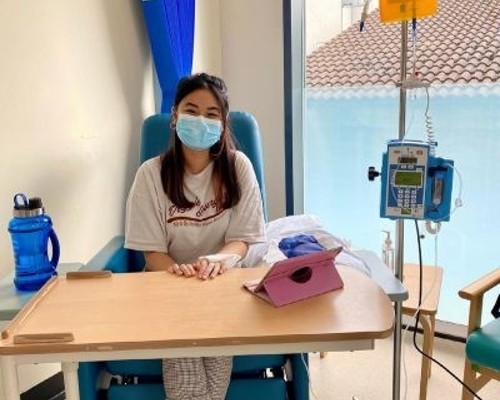
Jasmine Shen, who was working towards her A-levels when kidney disease struck out of the blue. Kidney Research UK

Despite the challenges of kidney disease, Jasmine was cast as Catherine of Aragon in the musical Six and has recently completed the Mamma Mia UK & International tour playing 'Ali. She is working with Kidney Research UK to help raise awareness of Nephrotic Syndrome and advocate for better treatments and outcomes for patients. Kidney Research UK
Researchers at the University of Bristol have made a breakthrough that could prevent certain kidney patients progressing towards renal failure.
With funding from charity Kidney Research UK, Dr Carl May from Bristol Medical School and his team have identified a new treatment pathway for patients with non-genetic (idiopathic) nephrotic syndrome (INS), targeting a still unknown factor that causes the progression towards kidney failure.
Nephrotic syndrome is a kidney condition that causes the organs to leak protein into the urine. This is caused by faults in the kidney's filtration system and in some cases, this can ultimately lead the patient to develop kidney failure. While it is a rare disease, it affects around 10,000 people each year in the UK with the majority of cases related to non-genetic causes1. The impact that it has on patients, many of whom will be children, can be devastating.
The scientists from Bristol Renal knew that there might be one or more factors in the blood (a substance that takes part in a biological reaction within the body) that caused the kidneys in INS patients to fail but have so far been unable to find out exactly what they might be. However, the team tried a different approach as they looked to identify how the factor worked and attempted to prevent its activation.
Using plasma from the blood of INS patients who were being treated with dialysis, the Bristol team wanted to confirm if a receptor (a molecular substance that causes a specific effect in the cell) known as PAR-1 works in conjunction with the unknown factor.
Dr May used the plasma from the patients and separately an activator of PAR-1 to investigate their effects on kidney cells in the lab. Both treatments caused distress in the kidney cells. Having confirmed the link between PAR-1 and the unknown factor, their results suggest that medications to block the receptor could be a viable option.
Steroids are currently the most effective treatment for INS, but these come with unpleasant side-effects and do not work equally well in all patients. Additionally, with the unknown factor circulating in the patient's blood, a transplant may offer some respite, however the disease often reoccurs and damages the new kidney, sometimes almost instantly. Dr May's discovery could revolutionise treatment options for patients with INS and offers the potential to eradicate steroid use and make transplantation a more viable option.
Dr Carl May, a postdoctoral research associate at Bristol Medical School at the University of Bristol said: "Researchers have made many attempts to identify the unknown factor that leads to nephrotic syndrome with little success. We knew that one or more factors were present in the blood and if we could identify how it works in kidney patients, we could create a clear pathway to treat them and ultimately slow their progression towards kidney failure. Using anti-PAR-1 treatments to block the effect of the factor could not only prevent kidneys failing but could make transplants a viable option for more patients with idiopathic nephrotic syndrome."
Using anti-PAR-1 treatment options would not only eradicate the need for steroids but also allow transplantation to be a more beneficial treatment as newly transplanted kidneys would no longer be as susceptible to the effects of the unknown factor.
Dr David Hughes, Kidney Research UK trustee and former president of the British Association for Paediatric Nephrology, added:"This discovery made by the Bristol team is a really interesting approach to tackling the issues around idiopathic Nephrotic Syndrome. Understanding how the factor reacts to anti-PAR-1 treatments sets a clear pathway for drugs that are already in development for other conditions. If successfully developed, they could drastically improve the lives of these kidney patients preventing them from having to suffer the consequences of kidney failure."
Anti-PAR-1 treatments are currently undergoing clinical trials for other health conditions to ascertain effectiveness and safety. The work conducted in Bristol opens new avenues for these treatments to be trialled for patients with non-genetic (idiopathic) nephrotic syndrome (INS).
If the safety of these treatments can be confirmed, INS patients could be taken off steroids and given new treatments in the next few years.
Paper
'Podocyte protease actuated receptor 1 stimulation in mice produces focal segmental glomerulosclerosis mirroring human disease signaling events' by C May et al. in the journal of the International Society of Nephrology.






